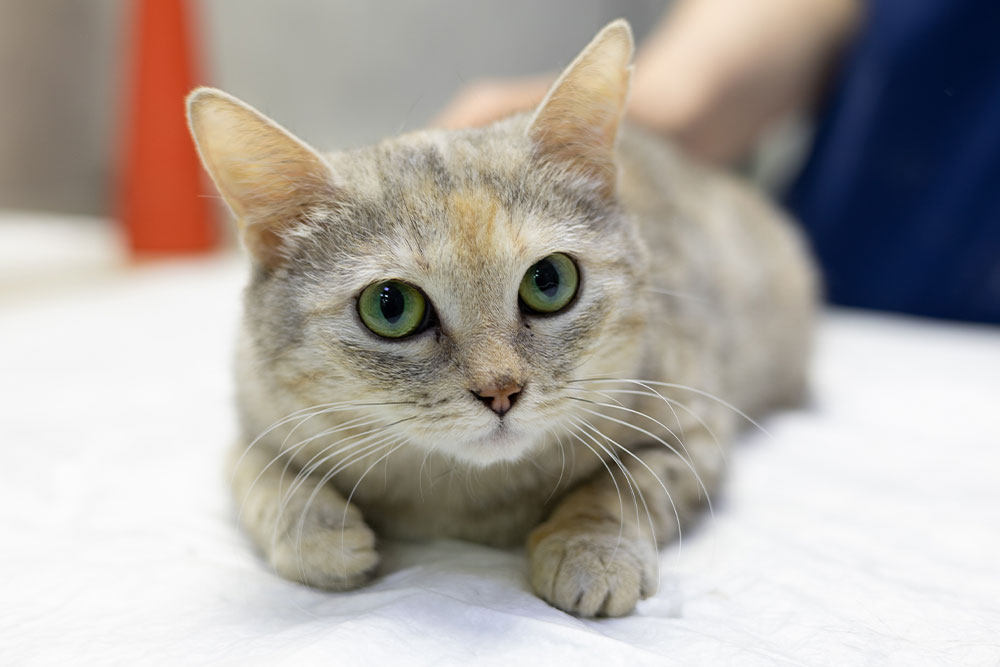Understanding Seizures in Cats: Causes, Treatment, and What Comes Next
If your cat has just experienced a seizure, your first reaction was probably a mix of fear, confusion, and a frantic Google search. Whether it’s the first episode or part of an ongoing pattern, it’s deeply concerning. At The Vale Veterinary Group in Cullompton, we’ve helped many cat owners navigate these scary situations. This guide explains what seizures are, why they happen, how we treat them, and how you can support your cat at home.
What Exactly Is a Seizure?
A seizure is a sudden burst of abnormal electrical activity in the brain. For some cats, this looks like full-body convulsions or loss of consciousness. For others, it might involve only a momentary twitch or zoning out. International Cat Care offers a helpful overview of the different seizure presentations.
There are a few broad categories. Generalized seizures, also called grand mal seizures, involve the whole body and often result in loss of awareness. Focal seizures are more localized—maybe a paw twitching or facial muscles tightening. There’s also a unique type called Feline Audiogenic Reflex Seizures (FARS), which are triggered by specific sounds like crinkling foil or jingling keys.
What Causes Seizures in Cats?
Seizures can be caused by a long list of underlying issues. Some, like idiopathic epilepsy, show up in young, otherwise healthy cats with no identifiable root cause. Others stem from medical conditions that affect the brain.
For instance, brain tumors, trauma, and inflammatory diseases can interfere with normal neurological function. NC State Veterinary Hospital outlines some of the more serious conditions that affect the brain and how they’re diagnosed.
Metabolic issues—like liver dysfunction, kidney disease, or low blood sugar—can also trigger seizures. Exposure to toxins is another common culprit. According to ASPCA Pro, substances like antifreeze, certain plants, and common medications are known to be dangerous to cats. Infectious diseases such as FIP, toxoplasmosis, or rabies can also be at fault. And finally, vascular events like strokes may disrupt blood flow to the brain, resulting in seizure activity.
Why Management Matters
Seizures aren’t always a one-time thing. Cats can develop chronic epilepsy or experience worsening symptoms over time. Without treatment, seizure frequency and severity can increase. In some cases, a cat may experience a prolonged seizure episode known as status epilepticus, which is a life-threatening emergency. If you’re not sure whether your cat’s symptoms require urgent care, this emergency assessment guide from AAHA is a great reference.
What a Seizure Looks Like
Seizures usually occur in three stages. First is the pre-ictal phase, or aura. You might notice your cat acting anxious, vocalizing more than usual, or suddenly seeking you out.
Next comes the seizure itself. This could include symptoms like muscle twitching, limb paddling, collapsing, drooling, or loss of bladder control.
After the seizure—the post-ictal phase—your cat may seem dazed, uncoordinated, or temporarily blind. This phase can last from a few minutes to several hours, depending on the severity of the episode.
How We Diagnose the Cause
When you bring your cat in, we start with a full history and physical exam. From there, we’ll determine which diagnostics are appropriate.
Bloodwork and urinalysis are typically first. These help us evaluate liver and kidney function, electrolyte levels, and metabolic health. We may also test for infections like FIV, FeLV, or toxoplasmosis. If needed, advanced imaging such as MRI or CT scans can help us look for brain tumors or structural issues. Sometimes, we’ll recommend a cerebrospinal fluid (CSF) tap to evaluate for inflammation or central nervous system infections.
Treatment Options
Treatment always depends on the root cause, seizure frequency, and your cat’s overall health.
For many cats, long-term management involves anticonvulsants like phenobarbital or levetiracetam (Keppra). If seizures are secondary to another illness—like a liver issue or toxin ingestion—we’ll focus on treating that primary condition.
In emergency situations, we may need to administer injectable medications to stop an active seizure. Cats with metabolic diseases may also benefit from prescription diets to support organ function and reduce seizure risk.
You can find more insights into treatment and long-term support from ASPCA Pet Insurance, which breaks down common epilepsy management strategies.
What Happens If Seizures Go Untreated?
Ignoring seizures can result in serious consequences. Repeated seizures may damage brain tissue or impair memory and behavior. There’s also a physical risk—falling from furniture or hitting sharp objects during an episode.
And if seizures progress to status epilepticus, the risk becomes life-threatening. That’s why timely diagnosis and consistent treatment are so critical.
Living with a Cat Who Has Seizures
Cats with well-managed seizures can absolutely live full, happy lives. There are a few simple adjustments that can make things safer at home.
Try to eliminate hazards—block off stairs, remove sharp-edged furniture, and provide cozy, secure places to rest. Keep your cat’s routine consistent and try to reduce stressful stimuli, especially if your cat has FARS or a history of idiopathic epilepsy.
Keeping a log of episodes is also incredibly helpful. Note the date, time, duration, and any unusual behavior before or after. Videos, when safely captured, provide your vet with valuable insight.
Can Seizures Be Prevented?
Not always—but there are ways to lower your cat’s risk. Preventing exposure to household toxins is key, as is regular monitoring of chronic health issues. And if you’re a breeder, it’s important to avoid breeding cats with a family history of epilepsy.
Preparing for Your Appointment
If your cat has had a seizure, bring as much information as you can to your visit. A written or digital log of seizure activity is extremely helpful. If you’ve recorded a video, bring it with you. And make sure we know about any medications, supplements, or recent changes in diet or behavior.
It’s also a good idea to ask questions like:
- What’s the most likely cause of the seizures?
- What medications will be prescribed, and what should I watch for?
- How often will follow-up visits or lab work be needed?
FAQs About Seizures in Cats
Are all seizures emergencies?
Not all seizures require an ER visit, but any new, recurring, or prolonged seizure should be assessed by a veterinarian.
Can cats live normal lives with seizures?
Yes. Many cats with epilepsy or managed medical conditions live well for years with the right care.
Do seizures mean my cat has a brain tumor?
Not necessarily. While tumors are one possibility, other causes like epilepsy, toxins, or metabolic disorders are far more common.
We’re With You
At The Vale Veterinary Group, we understand how confusing and overwhelming it can be to witness a seizure. But you’re not alone. If your cat has had an episode—or if you’re unsure whether what you saw was a seizure—we’re here to help. Contact us to schedule a consultation or learn more about your options. Together, we’ll create a plan that supports both you and your cat moving forward.








Leave A Comment